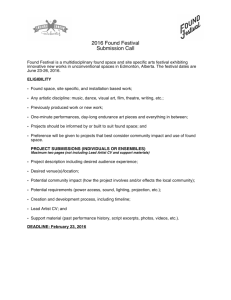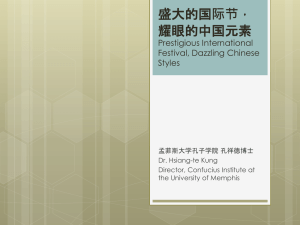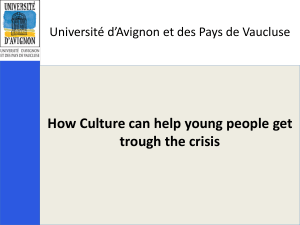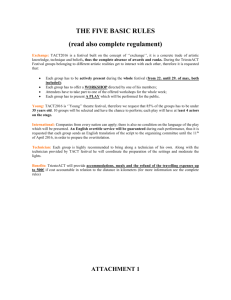MINISTÈRE DES AFFAIRES ÉTRANGÈRES ET EUROPEENNES
advertisement
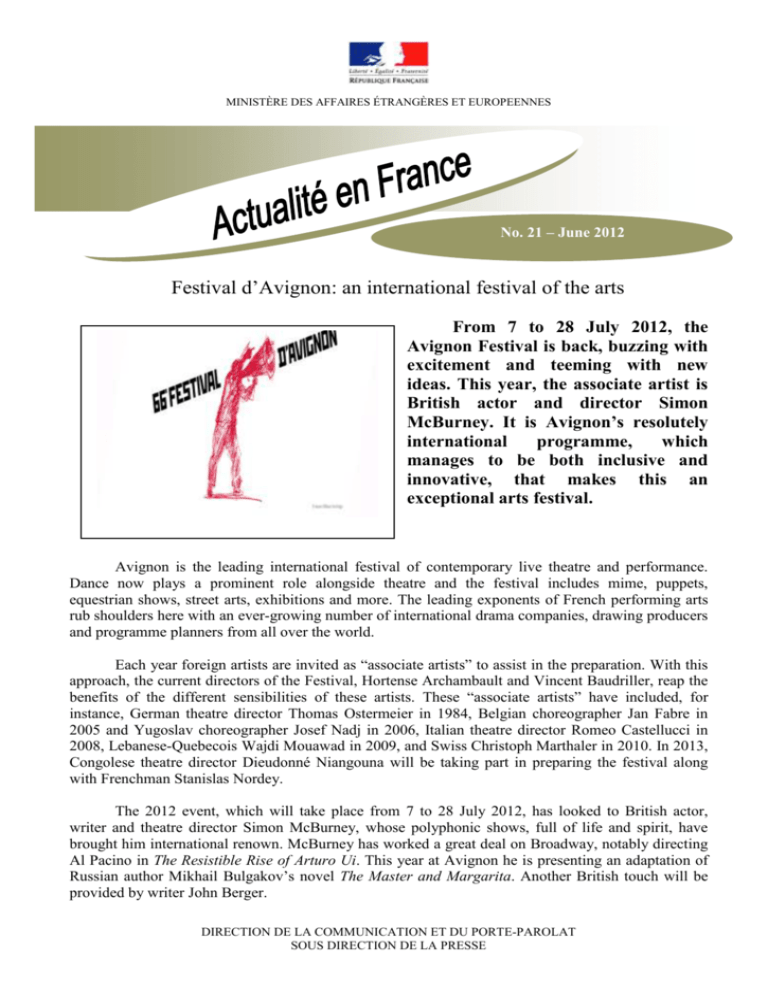
MINISTÈRE DES AFFAIRES ÉTRANGÈRES ET EUROPEENNES No. 21 – June 2012 Festival d’Avignon: an international festival of the arts From 7 to 28 July 2012, the Avignon Festival is back, buzzing with excitement and teeming with new ideas. This year, the associate artist is British actor and director Simon McBurney. It is Avignon’s resolutely international programme, which manages to be both inclusive and innovative, that makes this an exceptional arts festival. Avignon is the leading international festival of contemporary live theatre and performance. Dance now plays a prominent role alongside theatre and the festival includes mime, puppets, equestrian shows, street arts, exhibitions and more. The leading exponents of French performing arts rub shoulders here with an ever-growing number of international drama companies, drawing producers and programme planners from all over the world. Each year foreign artists are invited as “associate artists” to assist in the preparation. With this approach, the current directors of the Festival, Hortense Archambault and Vincent Baudriller, reap the benefits of the different sensibilities of these artists. These “associate artists” have included, for instance, German theatre director Thomas Ostermeier in 1984, Belgian choreographer Jan Fabre in 2005 and Yugoslav choreographer Josef Nadj in 2006, Italian theatre director Romeo Castellucci in 2008, Lebanese-Quebecois Wajdi Mouawad in 2009, and Swiss Christoph Marthaler in 2010. In 2013, Congolese theatre director Dieudonné Niangouna will be taking part in preparing the festival along with Frenchman Stanislas Nordey. The 2012 event, which will take place from 7 to 28 July 2012, has looked to British actor, writer and theatre director Simon McBurney, whose polyphonic shows, full of life and spirit, have brought him international renown. McBurney has worked a great deal on Broadway, notably directing Al Pacino in The Resistible Rise of Arturo Ui. This year at Avignon he is presenting an adaptation of Russian author Mikhail Bulgakov’s novel The Master and Margarita. Another British touch will be provided by writer John Berger. DIRECTION DE LA COMMUNICATION ET DU PORTE-PAROLAT SOUS DIRECTION DE LA PRESSE MINISTÈRE DES AFFAIRES ÉTRANGÈRES ET EUROPEENNES This 66th edition of the Festival will play host to renowned artists and regulars, notably Romeo Castellucci, Stéphane Braunschweig, Christophe Honoré, and Régine Chopinot, who is bringing with her Kanak dancers and musicians. Another event is the staging of Chekhov’s The Seagull by Arthur Nauzyciel in the Cour d’Honneur. True to its tradition of diversity, Avignon is also hosting several artists on their first visit to the festival, such as Chilean company Mapa, German director Nicolas Stemann and controversial South African choreographer Steven Cohen, who is already creating a stir with two projects, one of which will take place under the stage of the Cour d’Honneur, which has never been used before. This year all eyes and much talk will be focusing on Jérôme Bel and his company of disabled actors. Again this summer Avignon will be a unique open-air forum in which artists can enjoy discussions with an open and enthusiastic audience. With 40 or so works offered in over 300 performances in around 20 venues, the Festival every year sells over 130,000 tickets and attracts a majority of French spectators but also, with the aid of surtitles, increasing numbers of international visitors. For this international audience, the Centre Universitaire d’Études Françaises d’Avignon (CUEFA), which is in charge of international relations at the University of Avignon, has devised some original French courses linked with the Festival programme. For three weeks, students, teachers and anyone who wants to join in can take not only traditional courses but also sessions on theatre practice and attend five plays. Pupils come notably from Cairo and Tunis, but also from all over Europe and even China. A great way of getting involved in the theatre city that Avignon becomes each summer. Known for his work at the head of the Théâtre National Populaire (TNP), Jean Vilar has left his mark on the Festival d’Avignon, which he founded and ran until his death in 1971. In 1947, he launched Une semaine d’Art en Avignon [A Week of Dramatic Art in Avignon], which became the Festival the following year. The actor and director caused a stir by staging performances in an unusual venue, the Cour d’Honneur of the Palais des Papes, which remains the emblematic site of the Festival. From the mid-1960s onwards, Vilar extended the scope of the Festival to include dance, by inviting the likes of choreographer Maurice Béjart. It was a period that saw an increasing number of highly varied performances, with the arrival, alongside the “main” Festival, of a “fringe” Festival, regarded as one of the most important festivals of independent theatre groups in the world. By then the festival had infiltrated the entire city: the Carmelites Cloister, the Celestines Cloister, the Chapel of the White Penitents, theatres and more. Jean Vilar made his mark on the history of French theatre by assigning it a popular educational mission. At TNP and at Avignon, he breathed new life into the classics and presented modern and contemporary plays, as well as little-known foreign works. This has remained the guideline of the Festival, whose international reputation has continued to grow ever since through major events such as Peter Brooks’s The Mahabharata in 1985 or Antoine Vitez’s The Satin Slipper in 1987. Sylvie Thomas Websites for further information: www.festival-avignon.com http://www.univ-avignon.fr DIRECTION DE LA COMMUNICATION ET DU PORTE-PAROLAT SOUS DIRECTION DE LA PRESSE


